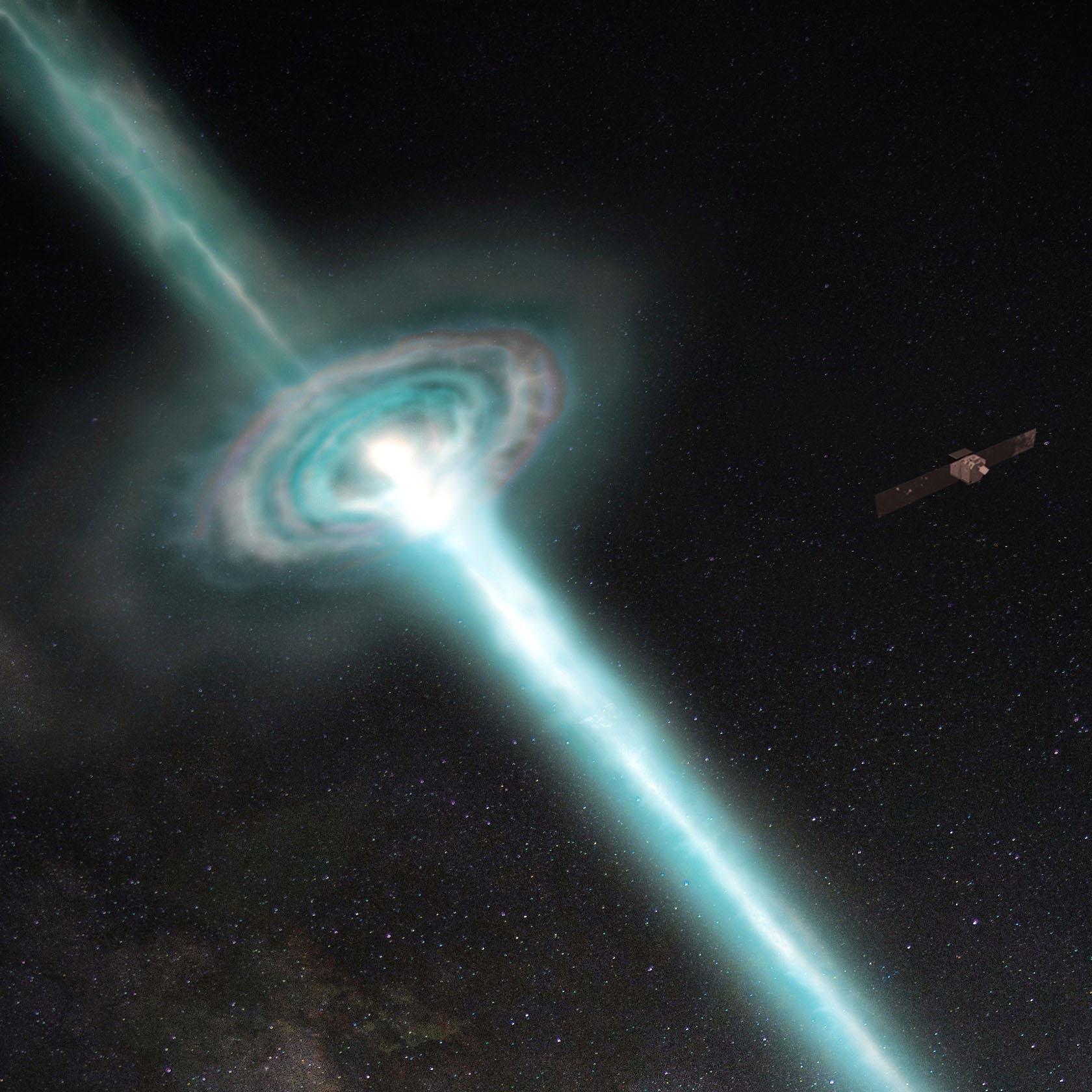

The MAGIC telescope system at the Roque de los Muchachos Observatory, La Palma, Canary Islands, Spain. Credit: Giovanni Ceribella / MAGIC Collaboration
In 2019, MAGIC telescopes detected the first gamma-ray burst at very high energies. This was the most intense gamma radiation ever obtained from such a cosmic object. But the GRB data has more to offer: With further analysis, MAGIC scientists could now confirm that the speed of light is constant in a vacuum, and is not energy dependent. So, like many other tests, the GRB data also corroborates Einstein’s theory of general relativity. The study has been published in Physical Review Letters.
Einstein’s General Relativity (GR) is a beautiful theory that explains how mass and energy interact with space-time, creating a phenomenon commonly known as gravity. GR has been tried and tested in various physical situations and on many different scales, and, postulating that the speed of light is constant, always proved to be an outstanding predictor of experimental results. However, physicists suspect that GR is not the most fundamental theory, and that there could be an underlying quantum mechanical description of gravity, known as quantum gravity (QG).
Some QG theories consider that the speed of light may depend on energy. This hypothetical phenomenon is called Lorentz invariance violation (LIV). Its effects are believed to be too small to be measured unless they accumulate for a long time. So how do you do that? One solution is to use signals from astronomical gamma-ray sources. Gamma-ray Bursts (GRBs) are powerful, far-away cosmic bursts that emit highly variable and extremely energetic signals. Therefore, they are excellent laboratories for experimental QG testing. Higher energy photons are expected to be more influenced by QG effects, and there should be many of those; These travel billions of years before reaching Earth, increasing the effect.

Artist’s impression of a gamma-ray burst observed by the MAGIC telescope system and satellite observatories.
Credit: Superbossa.com and Alice Donini
GRBs are detected daily with satellite detectors, which observe large portions of the sky, but at lower energies than ground-based telescopes like MAGIC. On January 14, 2019, the MAGIC telescope system detected the first GRB in the teraelectronvolt energy domain (TeV, 1 billion times more energetic than visible light), therefore, it registers by far the most photons energetic never observed from said object. Multiple analyzes were performed to study the nature of this object and very high energy radiation.
Tomislav Terzić, a researcher at the University of Rijeka, says: “No LIV study was done on GRB data in the TeV energy range, simply because there was no such data so far.” For more than twenty years, we anticipated that such observation could increase sensitivity to the effects of LIV, but we were unable to determine how much until we saw the final results of our analysis. It was a very exciting period. “
Naturally, the MAGIC scientists wanted to use this unique observation to search for the effects of QG. At first, however, they faced an obstacle: the signal that was recorded with the MAGIC telescopes fell monotonously over time. While this was an interesting finding for astrophysicists studying GRB, it was not favorable for LIV tests. Daniel Kerszberg, researcher at the IFAE in Barcelona, said: “when comparing the arrival times of two gamma rays of different energies, one assumes that they were emitted instantly from the source. However, our knowledge of processes in astronomical objects is not yet precise enough to determine the emission time of a given photon. “
Traditionally, astrophysicists rely on recognizable signal variations to limit photon emission time. A monotonic change signal lacks those characteristics. The researchers then used a theoretical model, which describes the expected gamma-ray emission before MAGIC telescopes began observing. The model includes a rapid increase in flux, maximum emission, and monotonic decay as seen by MAGIC. This provided the scientists with a control to search for LIV.
Careful analysis then revealed that there is no energy dependent time delay in the arrival times of gamma rays. Einstein still seems to hold the line. “However, this does not mean that the MAGIC team has been left empty-handed,” said Giacomo D’Amico, a researcher at the Max Planck Institute for Physics in Munich; “We were able to put strong constraints on the QG energy scale.” The limits established in this study are comparable to the best available limits obtained using GRB observations with satellite detectors or using terrestrial observations of active galactic nuclei.
Cedric Perennes, a postdoctoral researcher at the University of Padua, added: “We were all very pleased and feel privileged to be able to conduct the first study on the violation of Lorentz invariance on GRB data in the TeV energy range and open the door for future studies!
Unlike previous works, this was the first test of its kind carried out on a GRB signal at TeV energies. With this seminal study, the MAGIC team established a foothold for future research and even stricter testing of Einstein’s theory in the 21st century. Oscar Blanch, spokesperson for the MAGIC collaboration, concluded: “This time, we observed a relatively close GRB. We hope to see brighter and more distant events soon, allowing for even more sensitive testing. “
Reference: “Limits on violation of Lorentz invariance from MAGIC observation of GRB 190114C” by VA Acciari et al. (MAGIC Collaboration), July 9, 2020, Physical Review Letters.
DOI: 10.1103 / PhysRevLett.125.021301